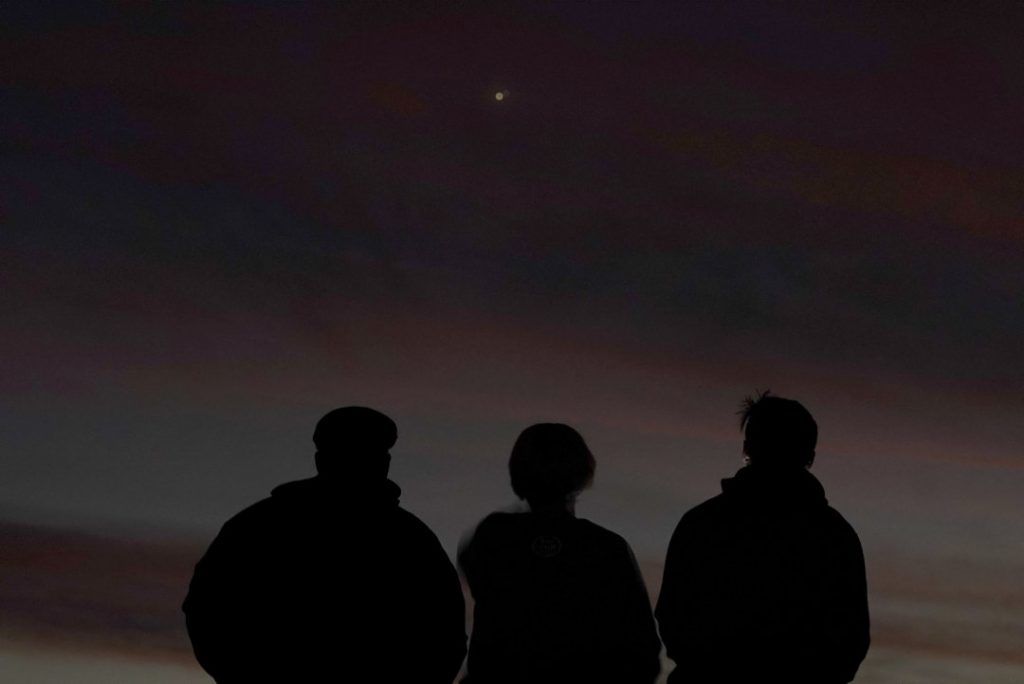The amazing and historic show that the bright planets Jupiter and Saturn put on last month continues through the first half of January, but this is the final act. On Dec. 21, they reached their closest conjunction with each other, only a tenth of a degree apart! The two planets hadn’t been that close since 1623 when Galileo was still alive!
Since then, Jupiter and Saturn continue to grow farther apart from night to night. They’re still quite a sight though! They pop out in the very low southwestern sky during evening twilight, but look for them as soon as you can because they set below the horizon less than an hour later. After mid-month, they’ll already be below the horizon as twilight fades. Before that happens, though, the planet Mercury will join Jupiter and Saturn. All three planets will be very close together in the twilight from Friday through Jan. 14, joined by a very thin crescent moon on Jan. 14.
Much higher in the Pottsville evening sky is the planet Mars. You can still easily spot it with its orange-red glow, even though it’s not nearly as bright as it was this past autumn. Unfortunately, Mars is now too far away from Earth to see any surface features with a telescope, but from Jan. 18 to 22 it’s possible to spot the very faint planet Uranus with the help of Mars. Just scan below and to the left of Mars for the next brightest “star” you run into. That’s Uranus, with a bit of greenish glow to it.
In the early morning skies, you can watch the Venus swan song through the first half of the month. You can’t miss Venus. It will be the brightest star-like object you can see, hanging very low in the southeastern sky in the morning twilight, barely above the horizon. On Jan. 10, a thin waning crescent moon will be just to the upper right of Venus. The next morning, Jan. 11, Venus and an even thinner crescent moon will be right next to each other, making for a glorious way to start your day.
The fabulous winter constellations put on the best celestial show in January! I absolutely love the great constellation Orion the Hunter and all of his great companion constellations that dominate the eastern evening sky.
At first glance, mighty Orion resembles a sideways bow tie, but without too much imagination you can see the torso of a huge man in your mind’s eye. The three bright stars that make up Orion’s belt are in a perfect row and jump right out at you. Extremely bright stars are on opposite corners of the great constellation. Rigel marks Orion’s knee, and Betelgeuse marks his armpit. You might want to keep your eye on Betelgeuse because at some point within the next million years Betelgeuse could explode as a tremendous supernova.
Elsewhere in Orion’s gang of constellations is Auriga, the retired chariot driver turned shepherd with its bright star Capella, marking a sheep draped over his shoulder. There’s also Taurus the Bull, appearing as a little arrow pointing to the right, outlining the bull’s face with the reddish star Aldebaran, marking the angry red eye of the beast. Just above Taurus are the Pleiades, a beautiful bright star cluster that resembles a tiny Big Dipper. The Pleiades star cluster is made up of more than 100 young stars, probably less than a hundred million years old. By 8 p.m., you’ll see a really bright star on the rise in the southeast. That’s Sirius, the brightest star in the night sky at any time throughout the year. If you draw a line through Orion’s belt and extend it to the lower left, it will point right to Sirius, a little more than 8 light-years away, with just 1 light-year equaling nearly 6 trillion miles.
In the northeastern evening sky, the Big Dipper appears to be standing on its handle. The Big Dipper is not an official constellation but instead makes up the bright derriere and tail of Ursa Major. To the upper right of the Big Dipper is the Little Dipper, hanging by its handle. Polaris, the North Star, shines at the end of the handle. The Little Dipper is also known as Ursa Minor, the Little Bear.
You can easily spot an upside-down “W” (or a right-side-up “M”) in the high northern heavens that outline the constellation Cassiopeia the Queen. Can you see the queen bound to her throne hanging by the ropes?
Despite the cooler or colder nights, depending on where you are, don’t miss the beauty of the night sky in January!
Lynch, an amateur astronomer and professional broadcast meteorologist, can be reached at mikelynch@comcast.net.




